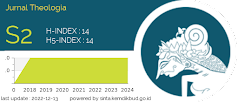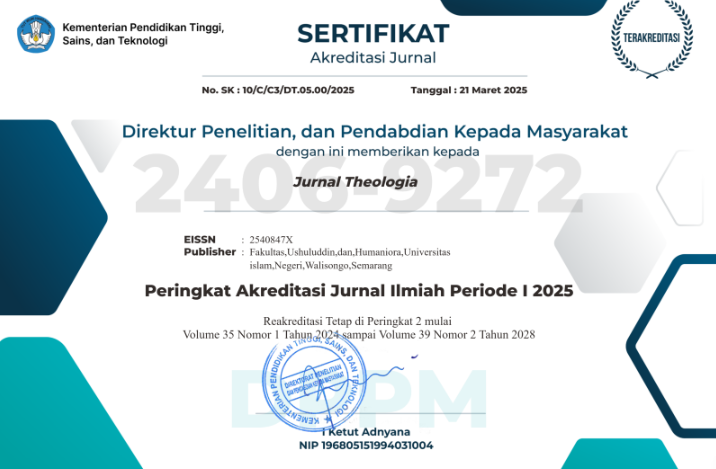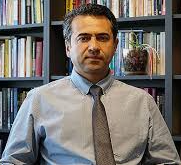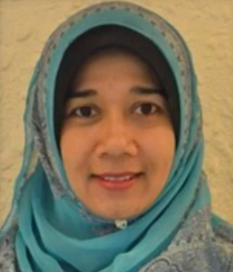Art: The Spiritual Path to God
DOI:
https://doi.org/10.21580/teo.2021.32.2.25034Keywords:
Art, Spirituality, God, Contemporary Islamic ArtAbstract
Art has long been a means of expression that serves to create aesthetic works and as a spiritual path that connects the individual to the transcendental dimension and God. In Islam, art has a vital role as a medium for achieving closeness to God, where works such as calligraphy, geometric art, and mosque architecture serve as decoration and meditative and reflective means. The background of this research is the increasingly strong influence of materialism and commercialization in modern art, which has led to the loss of spiritual dimension in artworks. This article uses literature study methodologies and case studies to explore how art remains relevant as a spiritual path in traditional and modern contexts. In the literature study, the author examines works that discuss the relationship between art and spirituality in the Islamic tradition and the contribution of Islamic art in strengthening awareness of God. The results of this study show that although the modern art world is often focused on the commercial aspect, art still has excellent potential to be a spiritual means that can connect individuals with God, personally and collectively. Contemporary Islamic art, through digital technology and interactive media, has managed to create an immersive and immersive spiritual experience for its connoisseurs.
Downloads
References
Aditia Muara Padiarta, Anwar Sanusi; Hajam; “Sufism and Hybrid Spirituality: The Brai Performance in Cirebon-Indonesia.” Epistemé: Jurnal Pengembangan Ilmu Keislaman 14, no. 1 (June 19, 2019): 117–30. https://doi.org/10.21274/epis.2019.14.1.117-130.
Faruqi, Ismail R., and Lois Lamya. The Cultural Atlas of Islam. New York: Macmillan Publishing Company, 1986.
George, M. Kennet. Picturing Islam: Art and Ethics in a Muslim Lifeworld. UK: Wiley-Blackwell, 2010.
Hadi W.M., Abdul. “‘A.D. Pirous Dan Estetika Lukisan Kaligrafi.’” In Melukiskan Islam: Amal Dan Etika Islam Di Indonesia. Bandung: Mizan, 2012.
———. Cakrawala Budaya Islam: Sastra, Hikmah, Dan Sejarah, Dan Estetika. Yogyakarta: IRCiSoD, 2016.
———. “Jagad Estetika Sastra Melayu.” Padang Panjang: ISI Padang Panjang, 2012.
———. “Seni Tak Bisa Dihalal-Haramkan.” Jaringan Islam Liberal, 2001. https://ahmad.web.id/sites/islamlib/seni-tak-bisa-dihalal-haramkan.htm.
Harimurti, Shubhi Mahmashony. “Seni Pada Masa Pemerintahan Dinasti Abbasiyah Tahun 711 – 950 Masehi.” Jurnal Kajian Seni 1, no. 2 (2015): 194–204. https://doi.org/https://doi.org/10.22146/art.11642.
Harun, Makmur, and Muhammad Bukhari. “SENI KALIGRAFI CINA DAN KALIGRAFI ISLAMI: Kajian Pengaruh Karya-Karya Seni Kaligrafi Cina Dan Seni Kaligrafi Islami Terhadap Seni Dan Budaya Di Alam Melayu.” ResearchGate, 2015. https://www.researchgate.net/search.Search.html?query=Seni+Islam+juga+mencakup+karya-karya+seni+yang+mengandung+dimensi+transendental+melalui+penggambaran+alam&type=publication.
Heidegger, Martin. Poetry, Language, Thought. New York: Harper Perennial Modern Classics, 2001.
Kahera, Akel Ismail. Deconstructing The American Mosque: Space, Gender, and Aesthetics. Austin: University of Texas Press, 2002.
Karyanta, Nugraha Arif. “Terapi Puisi: Dasar-Dasar Penggunaan Puisi Sebagai Modalitas Dalam Psikoterapi.” Jurnal Wacana 4, no. 1 (2012). https://doi.org/https://doi.org/10.13057/wacana.v4i1.34.
Machrus. “Simbol-Simbol Sosial Kebudayaan Jawa, Hindu Dan Islam Yang Direpresentasikan Dalam Artefak Masjid Agung Surakarta: Studi Semiotika Komunikasi Tentang Simbol-Simbol Sosial Kebudayaan Jawa, Hindu Dan Islam Yang Direpresentasikan Dalam Artefak Masjid Agung S.” Universitas Sebelas Maret, 2008. https://digilib.uns.ac.id/dokumen/detail/16900/Simbol-simbol-sosial-kebudayaan-jawa-hindu-dan-islam-yang-direpresentasikan-dalam-artefak-masjid-agung-Surakarta-studi-semiotika-komunikasi-tentang-simbol-simbol-sosial-kebudayaan-jawa-hindu-dan-islam-yang-direpresentasikan-dalam-artefak-masjid-agung.
Nasr, Seyyed Hossein. Islamic Art and Spirituality. New York: State University of New York Press, 1987.
Shihab, Muhammad Quraish. Wawasan Al-Quran Tafsir Maudhu’i Atas Pelbagai Persoalan Umat. Bandung: Bandung: Mizan, 1996.
Sulaiman. “Pertautan Emosi Sejarah, Magis, Dan Penjaga Mazhab: Analisis Terhadap Masjid Agung Kyai Gede Di Kotawaringin Barat, Kalimantan Tengah.” Ibda’: Jurnal Kebudayaan Islam 12, no. 1 (2014): 85–99. https://doi.org/https://doi.org/10.24090/ibda.v12i1.438.
Sumarjoko, Sumarjoko, and Hidayatun Ulfa. “Pandangan Islam Terhadap Seni Musik (Pergolakan Pemikiran Hukum Islam Dan Tasawuf).” Syariati : Jurnal Studi Al-Qur’an Dan Hukum 4, no. 02 (November 1, 2018): 203–12. https://doi.org/10.32699/syariati.v4i02.1177.
Supatmo, Supatmo, and Syafii Syafii. “Nilai Multukultural Ornamen Tradisional Masjid-Masjid Warisan Para Wali Di Pesisir Utara Jawa.” Imajinasi: Jurnal Seni 13, no. 2 (2019). https://doi.org/https://doi.org/10.15294/imajinasi.v13i2.21918.
Sutrisno, Mudji. “‘Seni Itu (Demi) Merawat Kehidupan.’” In Prosiding Seminar Nasional Estetika Nusantara. Surakarta: Institut Seni Indonesia (ISI) Surakarta, 2010.
Tillich, Paul. Dynamics of Faith. New York: Harper Torchbooks, 1957.
Downloads
Published
How to Cite
Issue
Section
License

This work is licensed under a Creative Commons Attribution-NonCommercial-ShareAlike 4.0 International License.




















